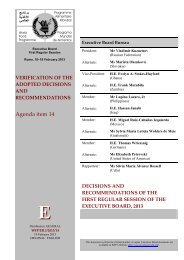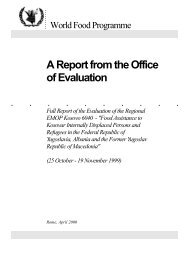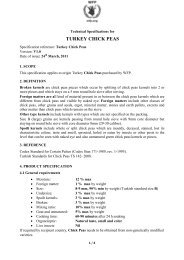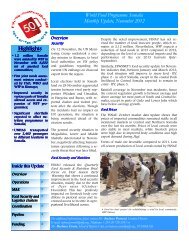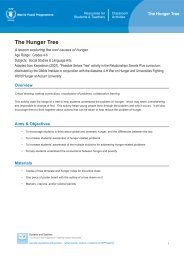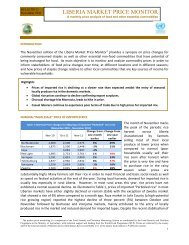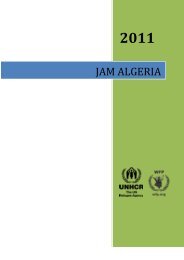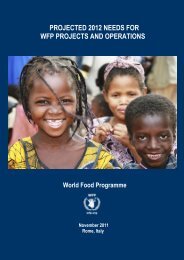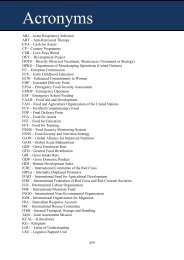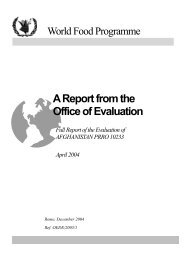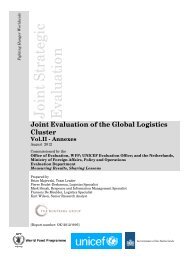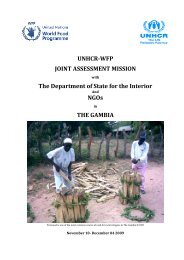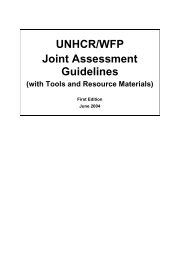The Potential for Scale and Sustainability in Weather Index Insurance
The Potential for Scale and Sustainability in Weather Index Insurance
The Potential for Scale and Sustainability in Weather Index Insurance
You also want an ePaper? Increase the reach of your titles
YUMPU automatically turns print PDFs into web optimized ePapers that Google loves.
68<br />
CASE STUDY 1<br />
AGROASEMEX IN MEXICO<br />
<strong>Weather</strong> data provider<br />
Prior to the launch of the second pilot, the National Water Commission (CONAGUA), which is<br />
the public entity responsible <strong>for</strong> manag<strong>in</strong>g the weather stations, granted access to the historical<br />
weather database <strong>and</strong> began produc<strong>in</strong>g a weekly electronic report with ra<strong>in</strong> value updates.<br />
2004-2008 scale-up<br />
Scal<strong>in</strong>g up of the weather <strong>in</strong>surance programme cont<strong>in</strong>ued <strong>in</strong> the follow<strong>in</strong>g years. In 2004,<br />
some regions from Puebla State were <strong>in</strong>corporated, crop coverage was extended to barley,<br />
<strong>and</strong> the <strong>in</strong>sured area, number of weather stations <strong>and</strong> sum <strong>in</strong>sured <strong>in</strong>creased.<br />
S<strong>in</strong>ce 2004, AGROASEMEX has cont<strong>in</strong>ued to work to extend coverage. It offers<br />
protection aga<strong>in</strong>st drought <strong>and</strong> excess moisture <strong>for</strong> all four of the most important gra<strong>in</strong>s<br />
<strong>in</strong> Mexican agricultural production: corn, beans, sorghum <strong>and</strong> barley. By 2008,<br />
1.9 million ha were protected under the programme, distributed over 251 weather stations,<br />
with a total sum <strong>in</strong>sured of US$132.5 million <strong>and</strong> premiums of US$22 million, benefit<strong>in</strong>g<br />
approximately 800,000 low-<strong>in</strong>come farmers.<br />
Target group<br />
<strong>The</strong> <strong>in</strong>surance is sold exclusively to the federal <strong>and</strong> state governments. <strong>The</strong> federal<br />
Government purchases the product through its PACC programme. It decides which states<br />
to cover <strong>and</strong> also responds to <strong>for</strong>mal requests <strong>for</strong> assistance from state governments.<br />
<strong>The</strong> target group consists of low-<strong>in</strong>come rural producers, ma<strong>in</strong>ly with non-irrigated<br />
crops. Of those who receive aid, 57 per cent have an <strong>in</strong>come of less than US$74 per<br />
month, while the rema<strong>in</strong>der have monthly <strong>in</strong>comes fluctuat<strong>in</strong>g from US$75 to US$222.<br />
Public policies state that, <strong>in</strong> the event of disaster, aid should go ma<strong>in</strong>ly to the most<br />
marg<strong>in</strong>alized regions (i.e. those with the lowest comb<strong>in</strong>ed development <strong>in</strong> sociodemographic<br />
variables, such as access to education, suitable hous<strong>in</strong>g <strong>and</strong> <strong>in</strong>come).<br />
In the period 2006-2007, 41 per cent of the regions supported were considered<br />
highly marg<strong>in</strong>alized.<br />
Product <strong>in</strong><strong>for</strong>mation<br />
Premium rates <strong>and</strong> subsidies<br />
<strong>The</strong> premium rate depends on the degree of marg<strong>in</strong>alization of the municipalities <strong>in</strong>cluded<br />
<strong>in</strong> the portfolio. <strong>The</strong> federal Government subsidizes 90 per cent of the premiums <strong>for</strong> those<br />
municipalities with high marg<strong>in</strong>alization, <strong>and</strong> 70 per cent <strong>for</strong> municipalities with low-tomedium<br />
marg<strong>in</strong>alization. <strong>The</strong> rema<strong>in</strong><strong>in</strong>g percentage of both is funded by the relevant<br />
state government.<br />
Triggers<br />
Every year AGROASEMEX evaluates <strong>and</strong> adjusts the trigger levels <strong>and</strong>/or the period<br />
covered to improve payouts <strong>for</strong> the upcom<strong>in</strong>g season. <strong>The</strong>re are two triggers: drought <strong>and</strong><br />
excess ra<strong>in</strong>fall. Trigger levels differ accord<strong>in</strong>g to the crop, region <strong>and</strong> crop growth stages<br />
(i.e. sow<strong>in</strong>g, flower<strong>in</strong>g <strong>and</strong> harvest<strong>in</strong>g).



